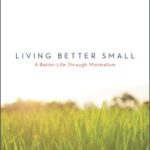 To get the “101” on my mindset, my philosophy of life, it all starts with this book. It’s all about the three values of life.
To get the “101” on my mindset, my philosophy of life, it all starts with this book. It’s all about the three values of life.
My book is available on Kindle and nook.
Living Better Small (The Book for Kindle)
Living Better Small (The Book for nook)
 To get the “101” on my mindset, my philosophy of life, it all starts with this book. It’s all about the three values of life.
To get the “101” on my mindset, my philosophy of life, it all starts with this book. It’s all about the three values of life.
My book is available on Kindle and nook.
Living Better Small (The Book for Kindle)
Living Better Small (The Book for nook)
 It has come to my attention that some people, some minimalists have a hard time determining whether a possession of theirs is valuable enough to be worth keeping. To be honest there is no solid mental process for determining these things. I myself struggle with this very often. When this happens to me, when I am divided between keeping something and discarding it, I ask myself a few key questions. These questions are:
It has come to my attention that some people, some minimalists have a hard time determining whether a possession of theirs is valuable enough to be worth keeping. To be honest there is no solid mental process for determining these things. I myself struggle with this very often. When this happens to me, when I am divided between keeping something and discarding it, I ask myself a few key questions. These questions are:
Question 1 is the deal breaker. If I spend more time maintaining something than I do using/enjoying it, bye bye.
Question 2 is also a deal breaker.
Question 3 is not quite so straight forward. So It will often require more thought.
Here are some examples of things I discarded in my life based on these guidelines:
Presently I do have a large comic book collection that I have not touched in ages. I have not gotten rid of it for investment purposes…….and admittedly sentimental reasons. But for all practicality, while it requires no maintenance or money to keep (anymore), it is taking up half my closet. I just can’t bring myself to do it. I am far from the perfect minimalist. But as with all things, it’s not the destination, but the journey that makes it all worth while.
 As a kid I was a big fan of Lego toys. As an adult……ok I am still a big fan of Lego toys. Few things bring me as much joy as creating something with my hands. Well as it just so happened not too long ago, I was strolling the mall and of course I walk into the Lego store, and there is was: A giant Lego MILLENNIUM FALCON. Now this is a tough purchase to refuse. Two things I love so much, Star Wars and Lego’s. $175, GOOD LORD. But it was calling to me: “Buy me Foppy. Buy me.” But I took this moment to think the item through.
As a kid I was a big fan of Lego toys. As an adult……ok I am still a big fan of Lego toys. Few things bring me as much joy as creating something with my hands. Well as it just so happened not too long ago, I was strolling the mall and of course I walk into the Lego store, and there is was: A giant Lego MILLENNIUM FALCON. Now this is a tough purchase to refuse. Two things I love so much, Star Wars and Lego’s. $175, GOOD LORD. But it was calling to me: “Buy me Foppy. Buy me.” But I took this moment to think the item through.
If I purchase this Lego ship I will spend two to three hours in euphoric joy building it. That is the best part of Lego’s, building with them. But what after that? At best it becomes a display piece in my home, but how long is that gonna be fun to look at before the novelty wears off? A month, tops. After that it is clutter. So in the end for $175 I get 3 hours of bliss and a cute piece for about a month. I can get all of this for considerably cheaper, not to mention the fact that any possessions I purchase should have greater longevity anyway.
So Instead of buying this display piece, I stand there in the Lego store and admire it for a few minutes. In that time I got as much joy as I would ever get having it displayed in my home. Total cost, $0.00. The Lego store is not far, so if I ever get the urge to see it again it will probably be there for a while. But I doubt that will have that urge.
This mindset can be applied to any potential purchase we have. Consider the endgame, or longevity of every material thing we wish to purchase. We will find that when we do that, we put the object into perspective and the urge to own it usually diminishes. But it does not make us lose any delight in the item itself. We just see it for what it is.
This thought process can be applied to these products (I figured more examples would be nice):
In general I will say that you have to be wary of objects that are useful merely because of their aesthetic value. like decorative pieces. Usually they look better in the store than they do in the home. Also, often times the aesthetic value is fleeting, a lot like infatuation.